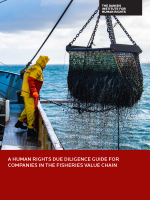
A Human Rights Due Diligence guide for companies in the fisheries value chain
Fish and seafood play an important role in meeting the nutritional needs of the growing global population. In recent years, the demand for seafood has increased exponentially: The annual consumption of aquatic foods per capita has more than doubled since 1960. Due to this growth, the fisheries sector provides considerable jobs and employment. In 2020, it was estimated that worldwide, up to 40 million people are directly engaged in fisheries.
Beyond the positive impact that the fisheries sector can have on food security and employment, the sector is connected to numerous severe human rights impacts, and companies in the sector must meet their responsibility to address these adverse impacts.
The HRDD guidance advises how to apply the UN Guiding Principles on Business and Human Rights in the fisheries sector, and also breaks down which human rights and environmental issues are salient in different parts of the value chain. This includes for example topics such as:
- Forced labour, modern slavery child labour and other exploitative labour practices, such as physical, emotional and sexual abuse, extremely low wages and long hours are prevalent at every stage of the value chain.
- Setting up infrastructure for fishing activities may adversely impact the livelihoods and wellbeing of local communities and small-scale fishers.
- Overfishing can damage ecosystems and affect local, small-scale and artisanal fisheries’ access to fish stocks.
- Lack of health and safety gear, standards and knowledge can endanger the health of workers, local populations and consumers alike and even lead to accidents and fatalities.
- Fraud and mislabeling of fish products can threaten sustainable seafood production and consumer health and safety. Certification standards may address the demand of consumers to verify sustainability, but labour and human rights issues are often not sufficiently considered.
The structure of the guide:
- Chapter 1 lays the foundation for this guide by describing the international human rights framework, the scope of the responsibility of businesses to protect rights, and how businesses in the fisheries industry can have both positive and negative human rights impacts.
- Chapter 2 offers an analysis of crosscutting salient human rights issues in the fisheries sector that can affect several diverse groups of rights-holders.
- Chapter 3 outlines the challenges that exist or may arise in each stage of the fisheries value chain from preparatory stages to distribution, marketing and retail.
- Chapter 4 provides tailored, step-by-step guidance to practicing HRDD for fisheries companies. It aims to provide concrete steps and recommendations for each HRDD step in accordance with the UNGPs and the Organisation for Economic Cooperation and Development’s (OECD) Guidelines for Multinational Enterprises (OECD Guidelines). It includes company examples and a summary of relevant resources, tools and guidance for each HRDD step, which companies in the fisheries sector can use and adapt based on their own business operations.
We strive to make the pdf versions of our publications etc. accessible for screen readers. If you experience any problems, please contact Digital Editor Stine Juhl Nielsen on stni@humanrights.dk
